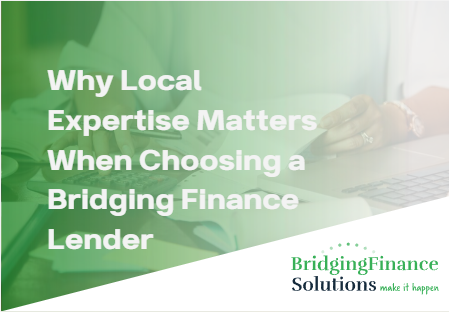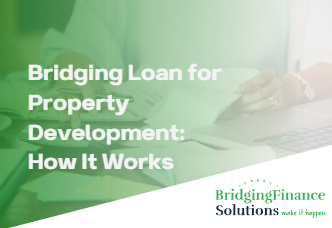Bridging finance can be a useful tool, whether you’re securing your dream home or grabbing a commercial investment opportunity. However, not all bridging loans are the same.
Understanding the difference between commercial and residential bridging finance is crucial for securing the right funding quickly. At Bridging Finance Solutions, we’ve assisted a range of clients, from first-time buyers to experienced developers, in finding the ideal solution.
In this guide, we will outline the main differences between residential and commercial finance to help you determine which bridging loan is best for your next project.
What is Residential Bridging Finance?

Residential bridging finance is a short-term bridging loan secured against a residential property. This short-term financial solution is often used to bridge the gap between selling a property and purchasing a new one.
Residential bridging finance provides a valuable lifeline for those who do not have the necessary funds readily available. It allows them to make the most of good investment opportunities while waiting for long-term finance to be arranged.
Typical Features of a Residential Bridging Loan
Residential bridging finance is fast and flexible, making it the perfect solution for landlords and individuals who own residential properties or want to purchase residential property.
The loan terms of residential bridging loans are usually 1-18 months, meaning that you can exit the loan much faster than other loan types.
Like any loan, you will pay interest on a residential loan. At Bridging Finance Solutions, we offer flexible repayment on all interest, and we allow interest to be paid monthly or rolled up to be repaid at the end of the loan.
When Residential Bridging Finance is Used
Residential bridging loans are incredibly versatile, making them a popular option for a range of financial needs, including:
Bridging The Gap Between a Sale
As we have already touched on, residential bridging finance can be a great solution for bridging the gap between the sale and the purchase of a new property.
When investing in a new property, you may be left in a ‘limbo’ situation while you wait for funds from your previous property to be released. Residential bridging loans allow you to pursue a purchase of a new property without worrying about sourcing the funds because bridging loans can be delivered fast.
Property Renovation
If you have recently purchased a property that requires minor or substantial renovations, you may find it difficult to obtain the necessary funding, especially if the property is not in a mortgageable state.
Residential bridging finance can be used to refurbish and renovate a property, allowing you to complete a refurbishment and move into your residential property without delay.
Auction Purchase
When purchasing a property at auction, you must contend with a rapid and often competitive process before completion, which is often unsuitable for typical mortgages. This is where auction finance is instrumental.
Residential bridging finance means that a buyer can finance their auction purchase without fear of delay or missing out. Auction bridging finance makes it much easier to secure a property at auction.
Buy-to-Let Purchase
When a landlord seeks to acquire a new property for investment or renovation purposes prior to leasing it to tenants, they typically use residential bridging finance to finance the purchase.
Short-Term Development Funding
Securing development funding for a project can be challenging, especially when there are issues regarding planning permission. Residential development finance provides a financial solution when developers require fast funding while waiting for long-term development finance.
Regulated Vs Unregulated Residential Bridging Loans

Residential bridging loans are known for their flexibility and can be categorised into two types: regulated and unregulated. At Bridging Finance Solutions, we provide both options to meet the diverse needs of our clients seeking residential bridging loans.
Regulated Bridging Loans
Regulated bridging loans, if secured against a property that is or will be the borrower’s main residence or their immediate family’s residence, are supervised by the Financial Conduct Authority (FCA).
Typically, regulated loans are not applicable for commercial properties or development projects, but if requested, such developments can sometimes be secured for regulated loans.
Unregulated Bridging Loans
Unregulated bridging loans are not regulated by the FCA and offer less consumer protection. However, this can also mean that the loan is more flexible and the borrower can access the funds faster than a regulated bridging loan.
What is Commercial Bridging Finance?
Unlike residential bridging loans, commercial bridging finance is specifically tailored to assist businesses or investors in acquiring commercial properties, funding expansion projects, or bridging cash flow gaps.
These loans are often used for larger and more complex transactions.
When Commercial Bridging Loans Are Used
Commercial finance can be used for a range of purposes; they are commonly used for:
Purchasing Commercial Property
If an investor wants to buy office spaces, shops, warehouses, or land for trade, commercial loans are often used to support these projects and provide financial backing at every stage.
Business Expansion or Relocation
If a business decides to open a new branch location or acquire a larger property for its base of operations, this can be quite a taxing financial investment, and so additional funding is usually required to make the venture more feasible, which is where commercial bridging finance comes in.
Auction Purchases
Because all auction purchases must be completed within 28 days, businesses looking to purchase commercial property at auction often need additional funding to bridge the gap between purchasing and finding a long-term financing solution.
Commercial auction finance is a great way to secure a property at auction without delay.
Converting Commercial Property to Residential
Property developers frequently use bridging finance to support the purchase and renovation of buildings, such as converting offices into apartments. This short-term funding helps cover the financial gap between acquiring a property and its later sale or refinancing.
Mixed-use Properties
Some buildings include both residential and commercial elements, like a shop with an apartment above. Securing finance for mixed-use properties can be complicated, and commercial bridging finance can help address this challenge.
Cash Flow Support
A company’s financial security frequently fluctuates, sometimes having surplus income and at other times facing difficulties. When an operational expense or a business opportunity arises, it is important for businesses to have an alternative funding option in place to ensure that they do not miss out, which is where commercial finance can be useful.
The Key Differences Between Commercial and Residential Bridging Loans

There are some key differences between commercial and residential bridging loans that are important to understand. These include:
Property Type
Residential bridging loans are intended for properties that are currently used or planned to be used as private dwellings. The types of properties that can be financed with a bridging loan include:
- Owner-occupied homes
- Houses undergoing refurbishment
- Flats or houses bought at auction.
- Buy-to-let properties
- New developments
Conversely, commercial bridging loans are intended for properties used for business or mixed purposes, which may include:
- Offices, warehouses or shops
- Hotels and care homes
- Land with or without planning permission
- Mixed-use properties
Regulations
As we have touched on, residential bridging loans can be regulated or unregulated. Regulated loans are often the most commonly used, and they are overseen by the Financial Conduct Authority, which provides added protections.
Residential loans can be unregulated, but this typically happens when a property is used for investment or business purposes. However, these loans often carry greater risk.
Commercial loans are often unregulated as they usually apply to non-residential properties. This gives businesses taking out these loans greater flexibility, but it also comes with greater risk that they should understand.
Interest Rates
Residential bridging loans generally have lower interest rates than commercial loans, mainly because residential properties present a lower risk and are more liquid. The rates typically vary from 0.5% to 1.5% per month, influenced by the loan amount, LTV, and borrower profile.
Commercial bridging loans typically have higher interest rates, reflecting the increased complexity and risk associated with commercial properties.
Interest rates shouldn’t be looked at in isolation – your lender must provide a service and advice that suits you. A low interest rate and a lender that can’t deliver, isn’t always the best idea.
Exit Strategy
Exit strategies differ between residential and commercial bridging loans. Residential bridging loans often depend on the sale of the property or the grant of a buy-to-let mortgage before the property owner can exit the loan.
When considering exit strategies for commercial bridging loans, borrowers usually have several options available. These options might include selling the property, generating rental income from tenants, or refinancing the loan with a commercial mortgage.
Each of these strategies provides a potential pathway to manage or exit the financial obligations associated with the bridging loan. Having a well-planned exit strategy in place is absolutely essential when applying for any financing options.
Borrower Type
The borrower profiles for commercial and residential bridging loans differ significantly. Residential loans are typically for individuals planning to buy or refurbish a home, as well as landlords aiming to grow their property portfolios.
Commercial bridging loans tend to be used by property developers and are generally aimed at property developers, investors and business owners.
Choosing the Right Bridging Loan
Choosing between a residential or commercial bridging loan depends solely on your objectives, the property type, and your repayment strategy. Although both options provide short-term financing, picking the wrong one may result in delays, increased costs, or project failure.
The most effective way to choose the right loan is by understanding its purpose. If you’re planning to use it for a personal property where you or a family member will live, a residential loan is probably the best option.
If you are a business owner or an experienced developer seeking funds for a larger project, you will likely require commercial financing.
How Bridging Finance Solutions Can Help

Through this blog, we hope to have given you greater insight into commercial and residential loans, providing you with the information you need to make an informed decision about which loan option best suits your individual needs.
If you need a cash injection quickly, you have come to the right place. At Bridging Finance Solutions, we pride ourselves on being able to provide a suitable loan option quickly.
Fill out our application form or get in touch with our team to make it happen today.




